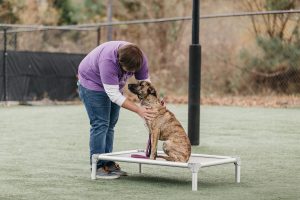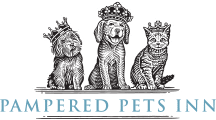 The month of February is dedicated to dog training and we all know how important it is to start a training program when your dog is still a puppy. But don’t worry if your puppy is now all grown up. Our professional dog training team here at Pampered Pets Inn has a few tips to get you started!
The month of February is dedicated to dog training and we all know how important it is to start a training program when your dog is still a puppy. But don’t worry if your puppy is now all grown up. Our professional dog training team here at Pampered Pets Inn has a few tips to get you started!
I have a new puppy, what should I focus on?
-
- For puppies, there is nothing more critical to healthy development than proper socialization and exposure to a variety of experiences and environments. While you should never force your puppy to do anything that’s too scary or overwhelming, the skills learned at a young age will shape adult behavior. An important objective is to prepare them for vet and grooming visits, where they will be weighed, as well as having their teeth, ears, tail and paws handled:
-
- Introduce a scale or raised table and reward your pup with treats each time they approach the new item, and again when they are placed upon it.
- Offer lots of calm praise and continue rewarding intermittently.
- If the pup tries to climb down, gently reset them and reward them when they are behaving and focused on you.
- Look in their ears, mouth and eyes, and hold their feet for a few seconds at a time.
-
Being consistent with this practice will make the vet and groomer a fun, relaxing place for your pup, and can even be highly beneficial in an emergency too!
What is Place and why is it important? Most pet owners desire having a dog that is calm and quiet when new guests arrive and an area where their pup can eat and relax comfortably. The place command is perfect for helping dogs master respectfulness and self-control.
-
-
- Begin by establishing place. This can be a blanket, bed, kennel, etc. Using your dog’s leash to guide them gently but firmly onto your designated “place”.
- Say the command verbally only once. Be clear and be sure to give your pup lots of praise and treats when they have all 4 paws on target.
- Do not allow your pup to leave the spot until you give the all-clear command (we like to use “free”).
- If need be, give a leash and verbal correction and reset your pup on place.
- Gradually increase the amount of time they are required to remain calmly on their spot. Eventually the dog will come to understand that “place” is where they are expected to be well-behaved and wait for your next cue.
-
How often should I practice? The journey of training is a lifelong one, and requires flexibility, patience and more importantly consistency. It only takes a daily commitment of 15-20 minutes to keep your pet’s skills sharp. Feeding time, walks, trips and guest visits are all opportunities to reinforce good behavior and build structure in your pet’s life. Dogs who can understand what to expect, and what is expected of them are calmer and more trusting of their human companions. And for most pets, a training session is an amazing way to exercise the mind and body. Some easy ways to incorporate training into your existing routine:
-
-
- Before each daily feeding, ask your pup to perform some of all their commands. When they work to earn their food, they are developing impulse control and problem-solving skills.
- Use their kibble as a motivator throughout the day – each piece is a reward for an appropriate behavior. This is a great way to speed the initial training process and will keep your pup motivated and engaged.
-
Our team of trainers are here to answer questions, provide complimentary assessments, and offer in-depth info on our training programs. Let us know how we can help you!
